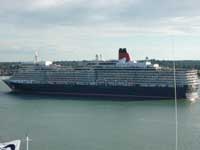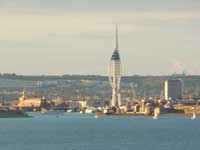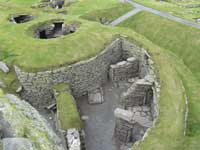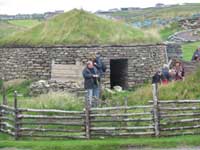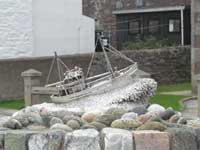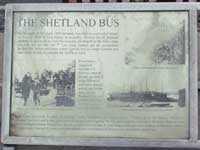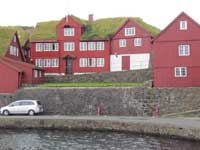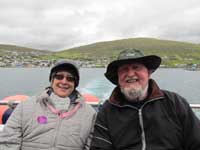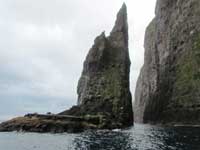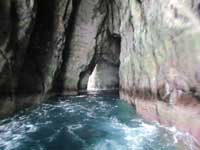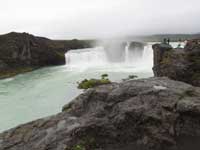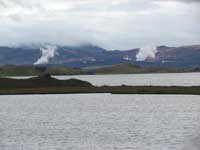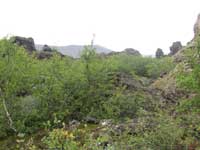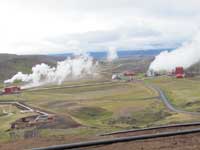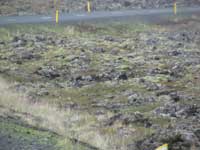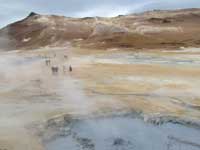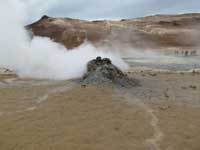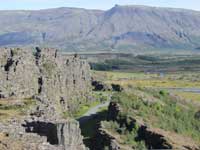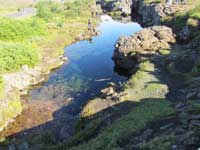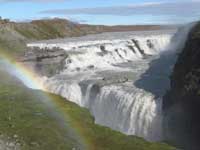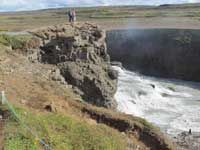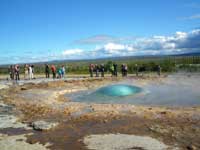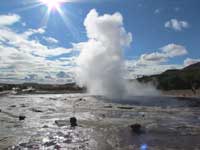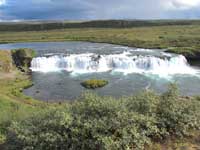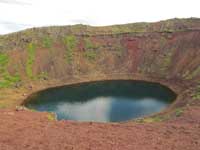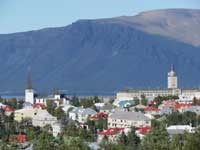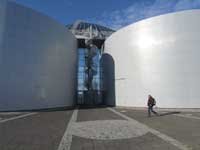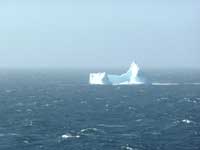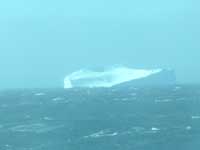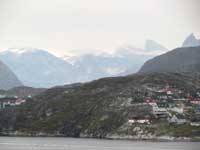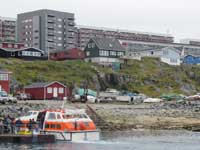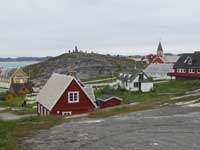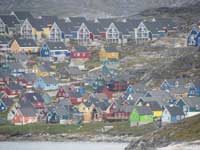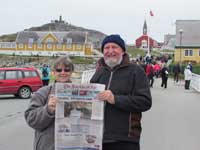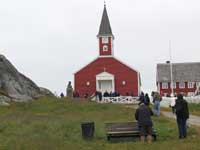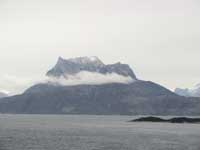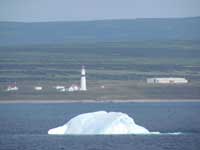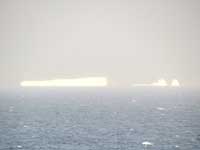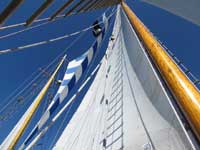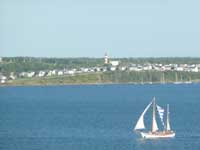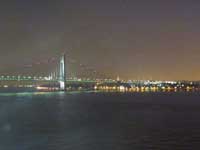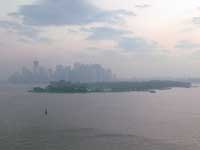Southampton to New York via Norway, Shetland,
Faroe Islands, Iceland, Greenland and Canada
in August and September 2011 on Crown Princess
All Points North (download 1MB PDF file) | Map
All Points North
England
Our trip to the Northern Hemisphere started with the usual interminable journey involving flights from Kaitaia to Auckland to Los Angeles to Heathrow. We did not make any stopovers as we just wanted to get there, but it did mean about 34 hours on the go. Never mind, we arrived in good shape and picked up the rental car without any hassles. We were given a diesel Audi A4, which exceeded our expectations and we were very glad of its comfort and capacity, given the number of hours we spent 'in the saddle' during the 8 days we were in the UK and the quantity of luggage.
Here we must break off the narrative to offer abject apologies to the many friends whom we were unable to visit; the time was so short and prioritising visits to family meant everything else had to be fitted in. With the itinerary taking in North Yorkshire, Surrey, East Sussex and Hampshire, the miles travelled were great.
We had been invited by Martin's contacts at Glyndebourne (for whom he still works in an honorary, advisory capacity) to their stunning production of 'Rusalka', so while we were down in East Sussex, we went to have a look at our old shop in Eastbourne; what a mistake! The whole parade of shops is so run down and it looks little better than a slum now. 'Our' shop is now a very scruffy and grubby-looking Halal butcher and is actually one of the less run-down looking businesses there. They do say 'never go back' and in this case 'they' are quite right! It was all very sad.
On August the 28th we presented ourselves at the cruise terminal in Southampton where we boarded the beautiful Crown Princess. We were soon settled in our very comfortable inside cabin, having decided that the premium for an outside with window or even a balcony would be wasted as we were unlikely to be sitting out on it in Arctic climes. This decision would be vindicated many times during the cruise, which featured some of the heaviest weather we have encountered.
We enjoyed a lovely, sunny early-evening departure from Southampton, an hour delayed as a sick passenger had to be off-loaded, complete with luggage and travelling companions. The delay did at least afford us a wonderful view of the new Cunard Queen Elizabeth as she sailed away ahead of us.
We spotted Osborne House on the Isle of Wight as we sailed serenely past. We then sailed past Portsmouth, which brought on a mild fit of nostalgia, as it is where we first met - though it has changed beyond recognition, if the waterfront views are anything to go by. The sun eventually set and we went to unpack and get ready for dinner, where we met the first of many new and interesting fellow passengers.
Next morning everyone was somewhat perplexed to see the White Cliffs of Dover, as we should have been considerably further north. The Captain came on to explain that we had turned back during the night to offload another sick passenger onto the Portsmouth lifeboat, it having been too rough at Dover for a safe transfer onto theirs. It seems to us that it is now becoming a habit for people to get sick on the first day of a cruise as this was the third time we had encountered delays for such a reason and we are, to be truthful, getting a little tired of it! Apparently it is a known phenomenon that the stresses and strains of the journey to join the ship, the unaccustomed lugging of heavy bags and the general excitement of the trip all combine to do for anyone with a weak heart or constitution. It must be dreadful for those affected and their families, especially those who do not know they have a weakness - however, we are considerably less sympathetic towards those who do know they are unwell and still choose to risk spoiling the trip for the other 2,999 holidaymakers on board! We have made a pact with each other that if either of us is taken ill in this manner, we will take our chances with the ship's doctor and not ask to be evacuated until the next scheduled port of call.
Norway
The delay caused by the medical evacuation meant we didn't arrive in Bergen until late evening on the 30th August, instead of early morning. The Captain would have missed out the port altogether except that he had to board about 100 passengers and most of the ship's provisions for the voyage as they had been diverted to Bergen after Hurricane Irene had caused delays and cancellations to flights from the Eastern Seaboard of the United States, just as they should have been delivering said passengers and supplies to England. He allowed passengers who wished to do so to disembark. It was dark, the rain was very heavy and it actually wasn't very practical to do so, with so many passengers queuing up to spend a couple of hours ashore, with little to see or do at that time of evening in the atrocious weather. We have visited Bergen several times so for us it was a mild disappointment but no more. However, many people had travelled long distances and were very upset to miss the opportunity to take a tour of the beautiful Norwegian fjords and surrounding area. Ironically, as we sailed away at 10pm, the skies cleared, it was still reasonably light and we had tantalising glimpses of colourful fishing villages and beautiful scenery.
Scotland
The next day brought us to Lerwick, in the Shetland Islands, where we anchored off shore as the harbour berths are not big enough to take our ship. We boarded the tender which took us ashore and walked to the car hire company where we had arranged to pick up a vehicle for the day. A diesel Renault Clio was perfectly adequate for the task of taking us to the south and Sumburgh Head. Here we explored the remains of the stone-age buildings, Viking longhouses and ancient 'brochs' at Jarlshof. A broch is a curiously designed tower-shaped, fortified farmhouse, peculiar to Scotland and possibly the first known example of multi-storey building. Most brochs have crumbled but those here are particularly well-preserved, having only been uncovered at the site by a violent storm in the late 19th or early 20th century - opinions vary.
After exploring Jarlshof, we drove to Scalloway to see the monument to the 'Shetland Bus'. This small but moving memorial celebrates the exploits of the Norwegian Resistance movement which, after Norway fell to German forces, made their base at Scalloway and from there smuggled arms and supplies to Norway and on the reverse journey, brought out refugees.
Faroe Islands
On September 1st we arrived at Torshavn, capital of the Faroe Islands. We were delighted to see that the harbour area had changed little since our first visit 40 years ago and the quaint, red-painted, turf-roofed buildings housing the parliamentary buildings still dominate the scene. We spent a happy morning exploring the narrow, cobbled lanes winding through the old quarter, amongst those buildings as well as the privately-occupied little cottages which nestled between them. As we passed one building, the name-plate on which we deciphered to read 'Office of the Prime Minister of the Faroe Islands', the door opened and a very smartly dressed gentleman, accompanied by an entourage of efficient looking minions, walked out. We later saw him in an official looking car and as we liked to fancy we actually had an encounter with the PM himself, looked for a photograph on the internet and are now satisfied that, in fact, we did!
That afternoon we had a coach and boat ride and these proved to be one of the highlights of the whole trip. After about an hour's drive on good roads through typical, rural Faroese scenery, we arrived at the picturesque village of Vestmanna where we embarked on small boats. These took us to the soaring Vestmanna Bird Cliffs which are the home of many varieties of seabird, including fulmars, shags, skuas, arctic terns, kittiwakes, guillemots, razorbills and many types of gulls as well as species we couldn't identify. In the season they are also covered in puffins but, sadly, we were a couple of weeks too late to see them as they had all migrated. The boat ride took us deep into many of the surprisingly colourful caves and fissures which abound in this deeply indented coastline. As we travelled through one particular opening, there were gasps of amazement as we negotiated impossibly tight bends and utter darkness only to come out into the sunshine further along. We emerged from behind a towering pinnacle which, from the sea, had looked like part of the cliff face and not a free standing rock at all. The entrance to the passage was completely hidden. Another cave had been part of a complex which the boats could meander through until a rock fall 10 years ago closed off the exit. Because of this, regulations required the wearing of hard hats by those of us on the open decks whilst in that particular cave... One cannot help but feel they were more ornament than use, but they occasioned much amusement and some photo-opportunities. In general, however, photographs cannot do this wonderful place justice - but we took far too many nevertheless.
Rather lumpy days and nights at sea, during which we crossed the Arctic Circle, eventually brought us, a little late, to Akureyri in Iceland. The storms had upset some people's equilibrium but fortunately we did not suffer from the 'motion of the ocean' - this was probably largely due to our cabin's position in the middle of the ship where it is most stable and also the fact that we couldn't see the mountainous waves; nor the horizon heaving up and down! One must expect high seas in the North Atlantic and anyway, if you can't take a joke, you shouldn't have joined!
Iceland
As we had not been to Iceland for 40 years, we were most interested to
see what changes would become apparent and so had arranged to join a tour
party to explore some of the northern part of Iceland around this area.
The biggest change we found was that there were roads! When last there,
we had driven over the lava flows and boulder-strewn fields and a journey
which took days then was accomplished in hours.
The beautiful Godafoss waterfall - the Waterfall of the Gods - while not
the highest or widest in the country, is one of the most spectacular waterfalls
in Iceland. The fall got its name around the year1000 AD when Christianity
became the official religion of Iceland and the chieftain threw his statues
of the Norse gods into the waterfall.
We also visited the extraordinary Lake Mývatn The name of the lake, translated
as The Lake of the Midges, comes from the huge numbers of the pesky creatures
to be found there in the summer. There were enough to be a mild irritation
during our visit, though they did not bite us, but we were told that in
the height of the summer they swarm in huge black clouds and it is sometimes
impossible to leave the bus. Indeed, the story is told of a horse being
suffocated to death by a swarm which found its way into and blocked the
poor beast's every orifice - not nice! The (dead) midges have had their
uses, however, and until fairly recently Lake Mývatn was one of the world's
primary sources of diatomaceous earth. The surrounding wetlands, which
are a nature conservancy area, have an exceptionally large number of water
birds, especially ducks. The River Laxá, which drains from the lake, is
particularly rich in brown trout and Atlantic salmon so is a great favourite
of anglers, who pay up to €3,000 for their licenses.
The incredible 'Luna landscape' of the thermal area, Námafjall, features
bubbling, sulphurous, grey mud pools, fumaroles and terrain where the
earth's crust was barely more than a few centimeters thick; one wandered
from the marked paths at ones peril. Since 1977 the area has been the
source of the geothermal energy used by a 60 MW power station supplying
much of the country's electricity.
The volcanic area of Krafla with its fields of lava formations, thought
to resemble figures from Hell, features the Víti crater. The Icelandic
word "víti" means "hell" and in early times Icelandic
people believed hell to be under volcanoes. Víti has a strikingly green
lake inside of it, the colour due to the minerals in the water.
Another rough night at sea brought us to the capital of Iceland, Reykjavik,
where there was no sign of bad weather and a warm, sunny day raised everyone's
spirits. We had booked another tour with the same company as at Akureyri,
Gateway to Iceland, whom we highly recommend. This expedition, universally
known as the 'Golden Circle', took us to Thingvellir, site of the world's
first parliament, which is in the Mid-Atlantic Rift between North America
and Europe and where the rift can be seen most clearly.
After an informative talk about the history and geography of the area, the bus was taken to a car park about a mile distant while we benefitted from a good walk through the rift and over a crystal clear river to meet it. From here we drove to our lunch stop at the spectacularly beautiful Gullfoss waterfall, with the spray painting rainbows through which we viewed the fall, it is justifiably one of the most visited in Iceland. As well as enjoying the magnificence of the falls, from several levels, and from a flat platform of rock right above them - not ideal for someone who suffers from vertigo. From here we could also see, at a distance, the Langjokull and Thorisjokull glaciers. Gullfoss Visitor Centre is very well set up for shoppers, the hungry and those more interested in learning about the area. We could not bear to waste time in the (reportedly very good) cafeteria so instead spent the allotted hour exploring this beautiful place and just bought sandwiches and coffee to eat on the bus.
Haukadalur was next on the itinerary. This area of hot springs is the
home of Geysir, which gave the name to the shooting fountains of boiling
water and steam known throughout the world as geysers. Nowadays it is
rare for Geysir to erupt and then with only a fraction of the force it
once had. The main geyser at the site now is Strokkur, which shoots up
regularly every three to 10 minutes, the eruption being signaled by a
brilliant blue bubble which lasts less than a second before it bursts
and sends up a jet of steam and water 30 metres into the air. To capture
the bubble was the ambition of all the photographers present and we really
struck lucky; the picture here was taken on Sarah's basic Pentax point-and-shoot
camera, while none of those with super-sophisticated or professional models
caught it. She was unbearably smug about it! However, it couldn't capture
the full height of the jet and Martin's superior Canon proved its worth
here. So honours are even, perhaps? See the photos below!
We were able to glimpse the still-steaming Eyjafjallajökull volcano, the
eruption of which in 2010 caused such disruption to the world's travellers.
The guide gleefully noted that the only airports in the northern hemisphere
to be unaffected were those in Iceland itself.
The implosion crater Kerid is a perfect example of what we all imagine a volcanic crater should be. It is one of several crater lakes in the area, but it is the one that has the most recognisable caldera still intact. The caldera is composed of a red volcanic rock but the various chemicals, lichens and even the light, cause the rock to glow with many colours from yellow to black and everything in between, making it a favourite subject for artists. While most of the crater is steep-walled with little vegetation, one wall is sloped more gently and blanketed with a deep moss, and can be descended fairly easily. In fact, a rather intrepid group of girls decided to test the waters and clambered down this mossy bank and took a dip; they had not bargained for the extremely cold water and did well to stay in for even the thirty squealing seconds they managed. The lake itself is fairly shallow but due to minerals from the soil, the water is an opaque and strikingly vivid blue-green.
Kerid's other big claim to fame is an amazing acoustic which has drawn many musician to stage concerts in the natural arena formed by the collapsed cone. Most famously, in the '80s, Iceland's home-grown pop star, Bjork, presented one of the country's biggest ever rock concerts. We were fortunate, we feel, that there was no such event planned while we were there and we were able to enjoy it in all its natural beauty and serenity. On our way back to Reykjavik, we made a quick stop at one of the country's prettiest 'small' waterfalls (all things are relative) at Faxi. Not many tour parties visit this fall as it is a little off the beaten track and there are no facilities there but it was one of our favourites; not as high or wide as Gullfoss, it seemed to sit particularly well within its landscape.
We were given a quick city-tour of Reykjavik, where we were amazed at how the city had grown in the 40 years since last seen. The old buildings were still there, but many are now dwarfed by modern steel and glass structures - some belonging to now-bankrupt banks - which are everywhere. There are also some magnificent buildings housing museums and art galleries, theatres and concert halls as well as Perlan (The Pearl). This is a landmark building which is situated on the highest hill in Reykjavik, where there had been hot water storage tanks for decades. In 1991 the tanks were updated and a glass geodesic dome structure placed on top, which houses a restaurant, museum and a viewing gallery. After enjoying the panoramic views from The Pearl we were delivered back to the ship, having completed a very full day and as we sailed away from Reykjavik we knew we would have many wonderful memories of things we had seen.
Greenland
Two full days and nights at sea, with lots of iceberg sightings along
the way, as well as dolphins (or more likely, porpoises) and whales, eventually
brought us to Greenland and its capital city, Nuuk. Greenland has held
a fascination for us for many years, ever since we flew over it and were
captivated by its extraordinarily beautiful ice formations, covering 95%
of the island. We were very excited to be finally reaching this land of
our dreams and our expectations were much too high so we were totally
unprepared for the rather drab, ice-less coastal strip and particularly
the city which, on first sight, seemed to consist of soviet-era concrete
block apartment buildings, not improved by the cold, overcast weather:
a bitter disappointment. It seems to us that Greenland is a country best
seen from the air.
We cheered up a bit once we got on shore, however, and had a chance to
explore the rest of the city with its brightly-coloured buildings, including
the bright red cathedral and contrasting modern centre with a magnificent
art gallery and cultural centre.
The coloured buildings were all mostly older and their colours originally denoted their use, with yellow, for example, being places of education, green medical facilities, blue administration and red religious or cultural. These colour codes are no longer very strictly adhered to but we noticed that the main buildings in each category still maintained the tradition. Added to this, cheerful people, mostly Inuit, made us welcome and in the end we spent an enjoyable day absorbing a totally different culture and environment. A jolly discovery was Santa's giant letter box, right on the waterfront, which stood in front of his Christmas Shop, and a closed building which can only have been his workshop...
During the afternoon the weather cleared and we were able to (just) see the snowy mountains behind the city as well as Sermitsiaq Island, a mountainous, uninhabited rock which has been adopted as the symbol of Nuuk since it is visible (weather permitting) from almost everywhere in the city. We left Nuuk during the evening, with our last impression more favourable than our first.
We made our way towards Nanortalik, the other scheduled port in Greenland. We were looking forward to this visit as the local people had arranged a number of events to showcase their way of life and folk traditions so we hoped we would get more of a feel for the country (and perhaps see more ice and snow?). Sadly the weather was not kind to us and we were unable to make landfall at Nanortalik after all. Although very disappointed, we felt even sorrier for the poor people of the town who had gone to so much trouble to prepare for our arrival and also, no doubt, hoped to make some money from the 3000 tourists who should have visited. This extract from the Ship's Log for the next two days sums up why we were unable to make it into port:
“8th September 2011 - During the night Crown Princess was maintaining
a south-easterly course toward Nanortalik, as we were proceeding towards
our next port of call the wind commenced to drastically increase up to
more than 50 knots. The latest weather report was showing that those conditions
were not going to improve and as we were also navigating in restricted
visibility and surrounded by icebergs, the Captain decided not to make
the call in Nanortalik but instead to continue the navigation towards
Halifax, which was considered safer for the navigation.”
“9th September 2011 - Once outside the fjord the Crown Princess set a
south-westerly heading towards Newfoundland. The waters of Newfoundland
are like the waters of Greenland and dotted with icebergs [remember the
Titanic!]. In this area the Canadian Ice Patrol monitors all ice movements.
The International Ice Patrol and Canadian Ice Service need the support
of all ships operating in the East Newfoundland waters in detecting and
identifying the iceberg danger in the area. All iceberg reports are important
in tracking the position of icebergs and providing accurate information
to mariners.”
Crown Princess participated in this monitoring activity, under the auspices
of the on-board Ice Pilot. Although we passengers saw only a few, medium
sized icebergs, we were told that there were many more, larger ones just
out of range of the naked eye which were spotted by the Officers of the
Watch and several look-outs posted around the ship as well as on the Bridge,
using their powerful binoculars. We had not previously been aware that
icebergs do not show up on ship's radar, and are particularly hard to
spot in high seas, all of which made us feel very content with the Captain's
caution.
On September 11th The whole ship's company, passengers and crew, regardless
of race, creed or colour, observed a minutes silence in memory of those
who died in the terrorist attacks on the USA on the same date 10 years
ago. There was also an interdenominational remembrance service. The captain
read a moving poem and it brought home the realization that there is not
a single person who has not been affected by those events in one way or
another. Another reminder of this date came a few days when we were in
New York and drove from the ship to the airport. Our route took us parallel
with an impromptu Memorial Walkway; the fence was lined with home-made
posters, each recording the name of someone who had died; it went on for
such a long way.
Canada
We arrived in Halifax, Nova Scotia without incident, after four days at sea instead of the scheduled three, and were happy to be met by bright sunshine, blue skies and a temperature of 21oC. We had visited Halifax a few years ago and done the usual tourist 'must do' visits so this time we didn't feel the need. The morning was spent at an out-of-town shopping mall, which may seem a strange use of time to any city-dwellers reading this but those of you who have visited us up here in the Far North of New Zealand will understand that access to a variety of shops and goods is a novelty! Our purchases were modest but more to the point, we had our fill of such places and were not sorry to leave the artificial air and hard, terrazzo flooring after a couple of hours. No doubt in a few months time we will be looking forward to another 'Mall Fix' - who knows where?
Our trip to the mall entailed a long bus journey, which took us through some of the residential and suburban areas of Halifax, something which always interests us wherever we travel as one gets a far better idea of the place being visited than just around the main centre or tourist trail. We particularly liked seeing the wonderful old, mainly wooden, houses which, being some distance inland, had survived the terrible explosion and fire that ravaged the harbour area and much of the city in 1917, when a French munitions ship collided with a Belgian relief ship. The collision sparked a fire on the munitions ship causing a massive explosion which still holds the record as one of the largest non-nuclear man-made explosions ever. The explosion and subsequent rebuilding had an important impact on the city, reshaping some of the neighbourhoods into progressive housing developments which have stood the test of time, being models of their kind even today.
In the afternoon we went on a tall ship harbour cruise, of which we had very few expectations but thought it would be a pleasant way to pass a couple of hours in the sunshine. It was a delightful experience and we are so glad we did it. We saw the harbour from sea level, rather than the 15th deck of a floating city, and the crew was very knowledgeable and informative. They told us that it is not always possible to do the trip under sail but this day the conditions were right so we had fun watching them work together to raise and lower the sails somewhat more theatrically than strictly necessary, we suspect, but very impressive nonetheless and a great show. We also had a much more peaceful time than if we had been under motorized rather than wind power. Our only slight concern was that we were sailing under the Jolly Roger! As we sailed away from Halifax that evening, our pretty tall ship sailed past us, looking not at all tall, indeed, more like a tiny bath toy against the leviathan that is the Crown Princess!
USA
A day and two nights at sea brought us to our final destination, New York, on 14th September. We sailed under the Verrazano Narrows Bridge at about 5.30am, and yes, we were up and on deck to watch, even at that ungodly hour! It was still dark as we made our way towards our disembarkation point in Brooklyn but the lights of the bridge as well as those of other vessels and New Jersey, Staten Island, Brooklyn and Manhattan made everything look magical. Day started to break with just a streak of yellow as we made our passage up the Hudson River towards Ellis Island and the Statue of Liberty, which appeared almost ethereal in the gentle lilac dawn. As we maneuvered onto our berth at Brooklyn the sun, a huge crimson ball, finally made its dramatic appearance above the horizon... magnificent!
We had planned to meet some old friends at their apartment in Manhattan
before having to head for the airport for an afternoon flight home. Sadly,
however, the ship's chaotic disembarkation procedures and consequent very
long queues for Immigration and Customs processing, which was very slick
once we got to the head of the line, used up all our available time and
so we didn't have time to get to Manhattan and had to make do with a quick
phone call instead. What made us even crosser was that when we got to
JFK airport we found our United Airlines flight to Los Angeles had been
rescheduled, some months ago, to leave an hour later than ticketed - so
we would have had time for a very quick visit after all. When we challenged
our travel agent about the change she simply said that as it was an hour
later, rather than earlier, they didn't bother to let us know as it 'only'
meant an hour more hanging around the airport! We shall not be using them
again as any agency which demonstrates such a cavalier disregard for its
clients and presumes to decide whether their time is precious or not doesn't
deserve the business.
That flight was bearable at only five hours but we were glad to be back
in the hands of Air New Zealand for the onward flight to Auckland, especially
as they upgraded us from Premium Economy to Business Class. There had
been an aircraft change on the outward flight to the UK which meant a
less comfortable and modern Premium Economy cabin and they had said they
would “see what we can do when you come home”. Not only did we get the
upgrade but they also credited us with 400 extra Air Dollars each to our
frequent flyer accounts - so altogether we are very happy with them!
Our local connecting flight was on time and we arrived home on the morning
of Friday 16th September, having been away for exactly four weeks (our
longest trip so far) and were delighted to find Sallie at the airport
with our car and the offer of a cup of coffee before heading home after
a truly memorable trip.
And here are some photos to prove we were really there...
Why are we holding up a copy of our local newspaper? The Editor invites readers to send in photos of the paper from far flung places they visit and runs an occasional column showing that the “Northland Age is even read in ...”. We figured Greenland might be the farthest flung or least-visited and sure enough it was printed in a recent edition! This area of NZ is referred to locally as the Real Far North (to distinguish us from pretenders further south) and the picture was captioned “From the Real, real Far North”, which amused us.
All Points North (download 1MB PDF file) | Map

